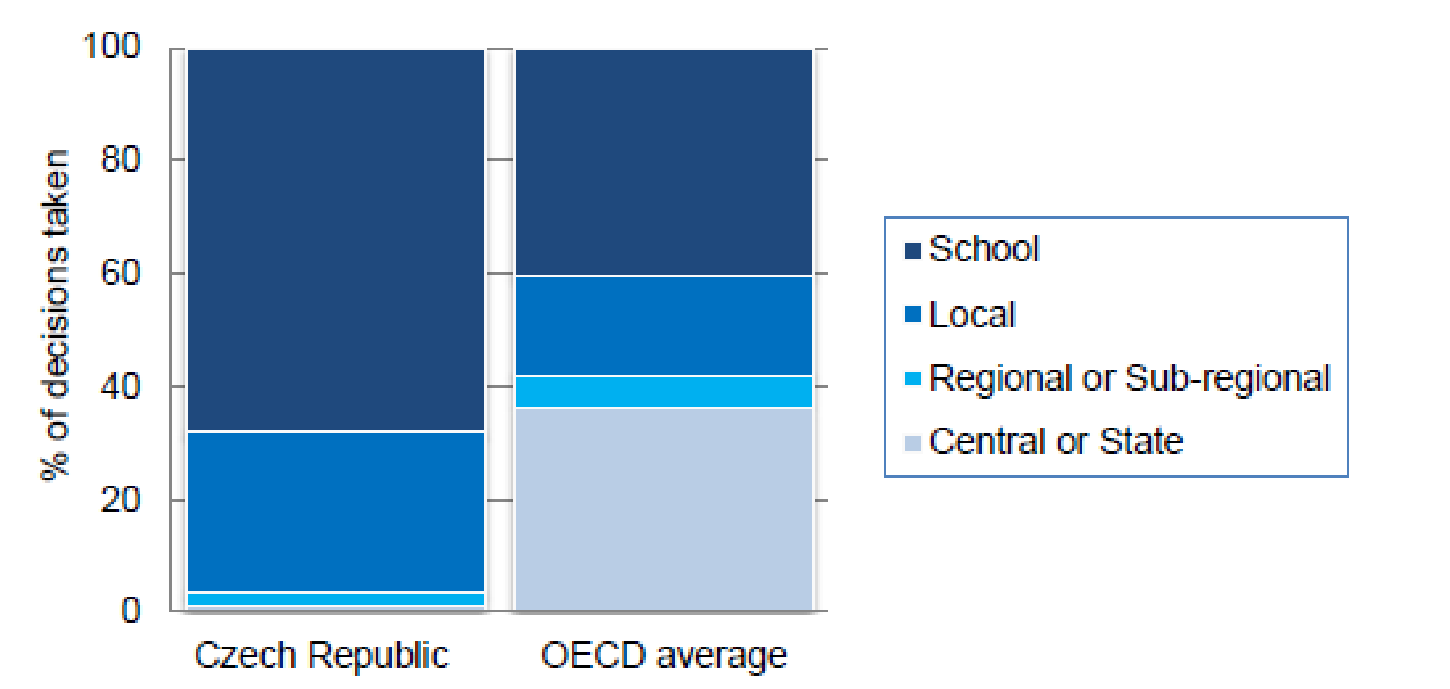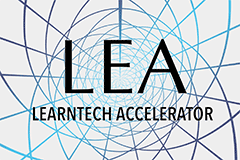Education Procurement in Czech Republic
Numbers
More information| Number of schools K-12 | Number of teachers K-12 | Number of students K-12 | Number of computers per student K-12 |
| 10.546[1] | 100.000[2] | 1.2 Mio[3] | 0,7[4] |
Sources:
[1] MSMT. www.msmt.cz/file/21631/download/ (last access: 08.04.2020)
[2] OECD (2016). The teaching workforce in the Czech Republic.
www.oecd-ilibrary.org/docserver/9789264262379-8-en.pdf?expires=1586332701&id=id&accname=guest&checksum=858ACB17EE2B41B80C57DD3C7C00A949 (last access: 08.04.2020)
[3] OECD (2016). The teaching workforce in the Czech Republic.
www.oecd-ilibrary.org/docserver/9789264262379-8-en.pdf?expires=1586332701&id=id&accname=guest&checksum=858ACB17EE2B41B80C57DD3C7C00A949 (last access: 08.04.2020)
[4] OECD (2015). PISA 2015 Results (Volume II) Policies and Practices for Successful Schools. P. 189.
Legislation of Education
More information- Strategy of Educational Policy of the Czech Republic by 2020
- Long-Term Plan of Education and Development of Educational Policy of the Czech Republic 2019–2023.
Source:
www.european-agency.org/country-information/czech-republic/legislation-and-policy
Organisations
More information| Organization responsible for education | Role of the organization | Website |
| Ministry of Education, Youth and Sports (MEYS) | ● Determines national education policy and long-term policy objective that guide the educational system and all-level education (pre-school, primary school, secondary school, vocational and technical education, upper secondary school, higher professional schools and adult education) | www.msmt.cz/?lang=2 |
| Czech School Inspectorate (CSI) | ● Monitors and analyses the education system and its quality (without higher education institutions) | www.csicr.cz/en/home?lang=en-us |
| National Institute of Education (NUV) | ● Develops information on issues regarding education levels from pre-primary through upper secondary, vocational and technical education
● Responsible for guidance and counselling of education ● Formulates the framework of education programmes and guides the development of school programmes |
www.nuv.cz/?lang=2 |
| National Institute for Further Education | Focuses on in-service teacher training | http://old.nidv.cz/old. nidv.cz/en/about-us.ep/index.html |
| Centre for Higher Education Studies | Develops policy and strategy for higher education | www.csvs.cz |
|
The organisation of pre-primary and compulsory education (between 6 and 15 years old) is the responsibility of the municipalities. There are many authorities having the right to establish schools: ministries, regions, municipalities, religious societies, churches and other legal entities. There are 14 regional government being responsible for governing upper secondary and tertiary professional schools, including the steering of the educational objectives being implemented in the educational institutions. |
||
|
Sources: |
||

Decisions taken in public lower secondary schools at each level of government (2010)
Source:
OECD (2012), Education at a Glance 2012: OECD Indicators, OECD Publishing, Paris, http://dx.doi.org/10.1787/eag-2012-en
Funding of education
More information| Type of schools | Source of funds |
| Public schools | Financing is mainly determined by the Ministry of Education, Youth and Sports, while regions and municipalities can add extra funds. National funds are allocated to the regions on a per-capita basis for schools’ costs such as salaries and learning materials. Regions and municipalities allocate these funds to schools. |
| Schools having students with special needs | Get extra funding on a per-student basis, and they can apply for extra funding in certain cases. |
| Private schools | State funding for teachers’ salaries and running costs:
|
| Church schools | Fully supported by the national budget |
|
Source: OECD 2016, www.oecd-ilibrary.org/docserver/9789264262379-7-en.pdf?expires=1587383892&id=id&accname=guest&checksum= |
|
Public expenditure on education ISCED (2011) (million EUR)
More information| Year | Primary education | Lower secondary education | Upper secondary education | Total |
| 2012 | 1151,3 | 1447,0 | 1570,5 | 4168,8 |
| 2013 | 1146,0 | 1393,4 | 1437,5 | 3976,9 |
| 2014 | 1166,4 | 1370,7 | 1354,1 | 3891,2 |
| 2015 | 1295,2 | 1477,4 | 1429,4 | 4202,0 |
| 2016 | 1304,7 | 1470,8 | 1387,7 | 4163,2 |
| Source: Eurostat (online data codes: educ_uoe_fine01) |
||||
Expenditure on educational institutions ISCED (2011) (Million EUR)
More information| Year | Expenditure | Primary education | Lower secondary education | Upper secondary education | Total |
| 2012 | Current expenditure | 1 086,0 | 1 381,3 | 1 617,4 | 4 084,7 |
| Capital expenditure | 119,2 | 142,6 | 83,6 | 345,4 | |
| Total | 1 205,2 | 1 524,0 | 1 701,0 | 4 430,2 | |
| Share of capital expenditure (%) | 9,9 | 9,4 | 4,9 | 7,8 | |
| 2013 | Current expenditure | 1 062,9 | 1 307,6 | 1 500,5 | 3 871,0 |
| Capital expenditure | 137,0 | 160,2 | 64,8 | 362,0 | |
| Total | 1 200,0 | 1 467,8 | 1 565,4 | 4 233,2 | |
| Share of capital expenditure (%) | 11,4 | 10,9 | 4,1 | 8,6 | |
| 2014 | Current expenditure | 1 052,3 | 1 250,5 | 1 380,3 | 3 683,1 |
| Capital expenditure | 164,8 | 188,2 | 94,7 | 447,7 | |
| Total | 1 217,1 | 1 438,7 | 1 475,0 | 4 130,8 | |
| Share of capital expenditure (%) | 13,5 | 13,1 | 6,4 | 10,8 | |
| 2015
|
Current expenditure | 1 187,8 | 1 363,0 | 1 427,8 | 3 978,6 |
| Capital expenditure | 160,4 | 182,1 | 122,8 | 465,3 | |
| Total | 1 348,2 | 1 545,1 | 1 550,6 | 4 443,9 | |
| Share of capital expenditure (%) | 11,9 | 11,8 | 7,9 | 10,5 | |
| 2016 | Current expenditure | 1 242,6 | 1 406,9 | 1 439,4 | 4 088,9 |
| Capital expenditure | 116,7 | 132,1 | 74,0 | 322,8 | |
| Total | 1 359,3 | 1 539,0 | 1 513,4 | 4 411,7 | |
| Share of capital expenditure (%) | 8,6 | 8,6 | 4,9 | 7,3 | |
| Source: Eurostat (online data code: educ_uoe_fini01) |
|||||
Investment plan for education / ICT in education
More information| Year | Amount in (€) | Main pillars of investments | Share of pillars (%) |
| 2019-2030 | 8,4 Mrd. € | Acquisition of competences for an active civic, professional and personal life focused on education
reducing inequalities in access to quality education and enabling pupils |
62% OECD (domestic economy)
13% (State) 25% subsidised by R&D |
Source:
Überblick zur Bildungs-, Forschungs- und Innovationslandschaft und -politik: Tschechische Republik.
www.kooperation-international.de/laender/europa/tschechische-republik/zusammenfassung/ueberblick-zur-bildungs-forschungs-und-innovationslandschaft-und-politik/#c49287 (last access: 08.04.2020)
Procurement Procedure
More informationThe public procurement system is decentralised, all the contracting authorities manage their own procurement without any central control. There is no central purchasing body, but it is allowed for contracting authorities to implement joint purchasing. The list of commodities that can only be purchased jointly is an effort by the government to insert some sort of centralization in the system.
The Ministry of Regional Development (MoRD)
- proposes legislation and implement the regulations in connection with public procurement procedures
- provides support and help for contracting authorities
- manages the online Public Procurement and Concessions Portal
- responsible for the Information System on Public Procurement
Office for the Protection of Competition (OPC):
- supervises the public procurement procedures in terms of compliance to the legislation
- is authorized to impose any penalties, sanctions and even bans in case of any breaches. Against its decisions, appeals can be submitted to the Regional Court in Brno and to the Supreme Administrative Court.
Supreme Audit Office (SAO): performs external reviews in terms of compliance with the regulations and forwards its findings to the Parliament, the administration and the general public together with recommendations on how to use the public funds. It has no authority to impose any sanctions.
Source:
Public procurement – Study on administrative capacity in the EU Czech Republic Country Profile:
https://ec.europa.eu/regional_policy/sources/policy/how/improving-investment/public-procurement/study/country_profile/cz.pdf

